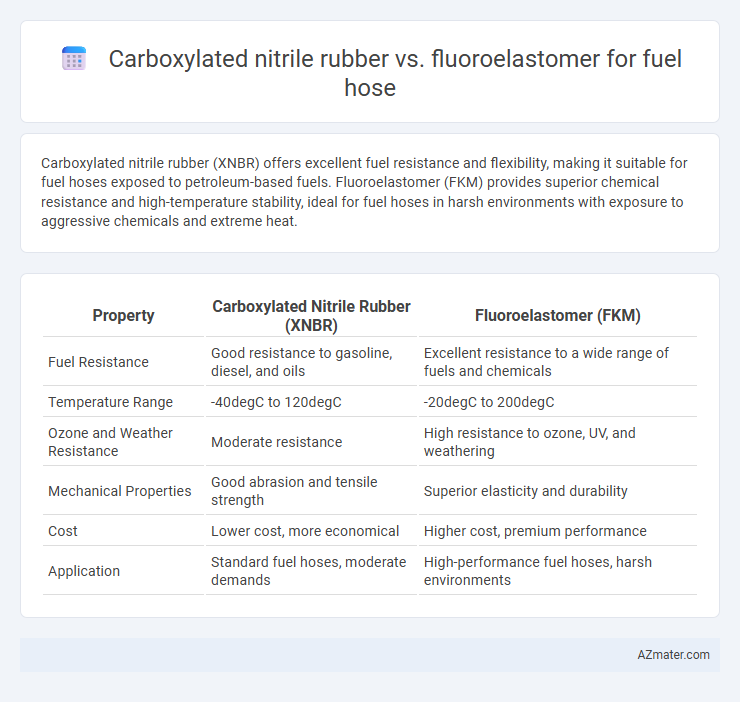Carboxylated nitrile rubber (XNBR) offers excellent fuel resistance and flexibility, making it suitable for fuel hoses exposed to petroleum-based fuels. Fluoroelastomer (FKM) provides superior chemical resistance and high-temperature stability, ideal for fuel hoses in harsh environments with exposure to aggressive chemicals and extreme heat.
Table of Comparison
| Property | Carboxylated Nitrile Rubber (XNBR) | Fluoroelastomer (FKM) |
|---|---|---|
| Fuel Resistance | Good resistance to gasoline, diesel, and oils | Excellent resistance to a wide range of fuels and chemicals |
| Temperature Range | -40degC to 120degC | -20degC to 200degC |
| Ozone and Weather Resistance | Moderate resistance | High resistance to ozone, UV, and weathering |
| Mechanical Properties | Good abrasion and tensile strength | Superior elasticity and durability |
| Cost | Lower cost, more economical | Higher cost, premium performance |
| Application | Standard fuel hoses, moderate demands | High-performance fuel hoses, harsh environments |
Introduction to Fuel Hose Materials
Carboxylated nitrile rubber (XNBR) and fluoroelastomers (FKM) are primary materials used in fuel hose manufacturing due to their chemical resistance and durability. XNBR offers excellent abrasion resistance and fuel compatibility, making it suitable for gasoline and diesel applications. Fluoroelastomers provide superior resistance to high temperatures, fuels, and harsh chemicals, ensuring extended service life in demanding fuel delivery systems.
Understanding Carboxylated Nitrile Rubber (XNBR)
Carboxylated nitrile rubber (XNBR) features enhanced oil and fuel resistance due to its carboxyl groups, providing excellent abrasion resistance and mechanical strength compared to standard nitrile rubber. XNBR's polar nature improves bonding in fuel hose applications, making it suitable for handling fuels and oils with moderate temperature ranges up to approximately 120degC. While fluoroelastomers offer superior chemical and thermal stability for high-performance fuel hoses, XNBR presents a cost-effective alternative that balances durability and fuel compatibility in less demanding environments.
Overview of Fluoroelastomer (FKM)
Fluoroelastomer (FKM) is a high-performance synthetic rubber known for its exceptional resistance to heat, fuel, oils, and chemicals, making it ideal for fuel hose applications. Its molecular structure provides superior impermeability to hydrocarbons and excellent durability in harsh environments compared to carboxylated nitrile rubber (XNBR). FKM maintains flexibility and integrity at temperatures up to 200degC, ensuring long-lasting fuel hose performance in demanding automotive and industrial systems.
Chemical Resistance in Fuel Hose Applications
Carboxylated nitrile rubber (XNBR) exhibits strong resistance to aliphatic hydrocarbons, oils, and fuels, making it suitable for fuel hose applications with moderate chemical exposure. Fluoroelastomers (FKM), however, provide superior chemical resistance to a broader range of aggressive fuels, including aromatics, oxygenates, and hydrocarbons with high sulfur content, ensuring enhanced durability and longevity. Fluoroelastomer fuel hoses maintain structural integrity and performance under extreme temperatures and harsh chemical environments typical in modern automotive fuel systems.
Temperature Performance Comparison
Carboxylated nitrile rubber (XNBR) exhibits excellent resistance to fuel and oil but typically operates effectively within a temperature range of -40degC to 120degC, making it suitable for standard fuel hose applications. Fluoroelastomers (FKM), however, offer superior temperature performance, withstanding continuous exposure from -26degC up to 200degC, which ensures higher durability and resistance to thermal degradation in extreme engine environments. The enhanced heat resistance of fluoroelastomers makes them a preferred choice for fuel hoses in high-temperature conditions, including turbocharged engines and aerospace applications.
Mechanical Properties and Durability
Carboxylated nitrile rubber (XNBR) exhibits excellent tensile strength and abrasion resistance, making it suitable for fuel hoses exposed to mechanical stress. Fluoroelastomers (FKM) demonstrate superior chemical resistance, high temperature tolerance up to 200degC, and exceptional durability against fuel swelling and ozone exposure. For fuel hose applications, fluoroelastomers offer enhanced longevity and mechanical stability in aggressive fuel environments compared to carboxylated nitrile rubber.
Cost Analysis: XNBR vs. FKM
Carboxylated nitrile rubber (XNBR) offers a cost-effective solution for fuel hoses due to its lower raw material and processing expenses compared to fluoroelastomers (FKM). XNBR provides adequate fuel resistance and mechanical strength at a fraction of the price, making it suitable for applications where budget constraints are critical. Fluoroelastomers, while significantly more expensive, deliver superior chemical resistance and temperature tolerance, justifying the higher cost in demanding environments.
Environmental and Regulatory Compliance
Carboxylated nitrile rubber (XNBR) offers strong resistance to fuels and oils while meeting many environmental regulations due to its relatively low VOC emissions and recyclability. Fluoroelastomers (FKM), known for exceptional chemical and heat resistance, comply with stringent global standards such as REACH and RoHS, often used in applications demanding long-term durability under harsh conditions. Both materials address environmental and regulatory compliance, but FKMs typically provide superior performance in meeting the strictest fuel hose certification requirements for automotive and aerospace industries.
Application Suitability for Automotive Fuel Systems
Carboxylated nitrile rubber (XNBR) offers excellent resistance to gasoline, diesel, and ethanol blends, making it suitable for fuel hoses in standard automotive fuel systems due to its durability and flexibility. Fluoroelastomer (FKM) provides superior chemical resistance and thermal stability, ideal for high-performance or turbocharged engines where exposure to aggressive fuels and elevated temperatures is common. The choice between XNBR and FKM hinges on the specific fuel type and operating conditions, with FKM preferred for extreme environments and XNBR for cost-effective, reliable everyday fuel hose applications.
Conclusion: Selecting the Optimal Fuel Hose Material
Carboxylated nitrile rubber (XNBR) offers excellent resistance to abrasion and moderate fuel compatibility, making it suitable for general fuel hose applications with cost-effectiveness and durability. Fluoroelastomers (FKM) provide superior chemical resistance, high temperature tolerance, and long-term stability against aggressive fuels and additives, ideal for demanding automotive and aerospace fuel systems. Selecting the optimal fuel hose material depends on fuel type, operating temperature, environmental exposure, and budget, with XNBR preferred for standard use and FKM chosen for high-performance, chemically aggressive environments.

Infographic: Carboxylated nitrile rubber vs Fluoroelastomer for Fuel hose
 azmater.com
azmater.com